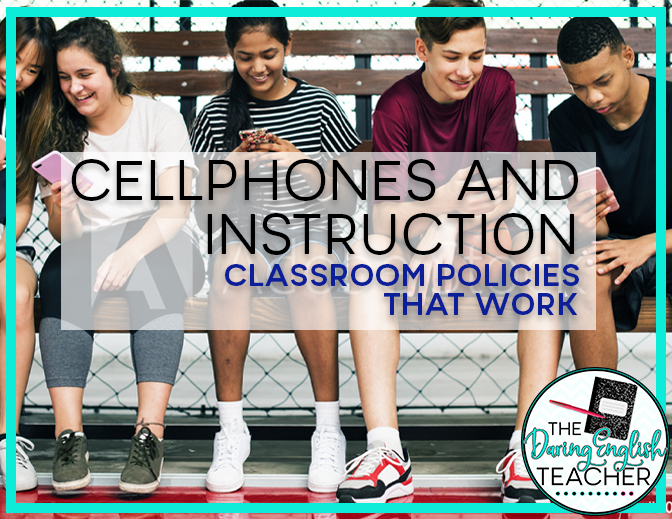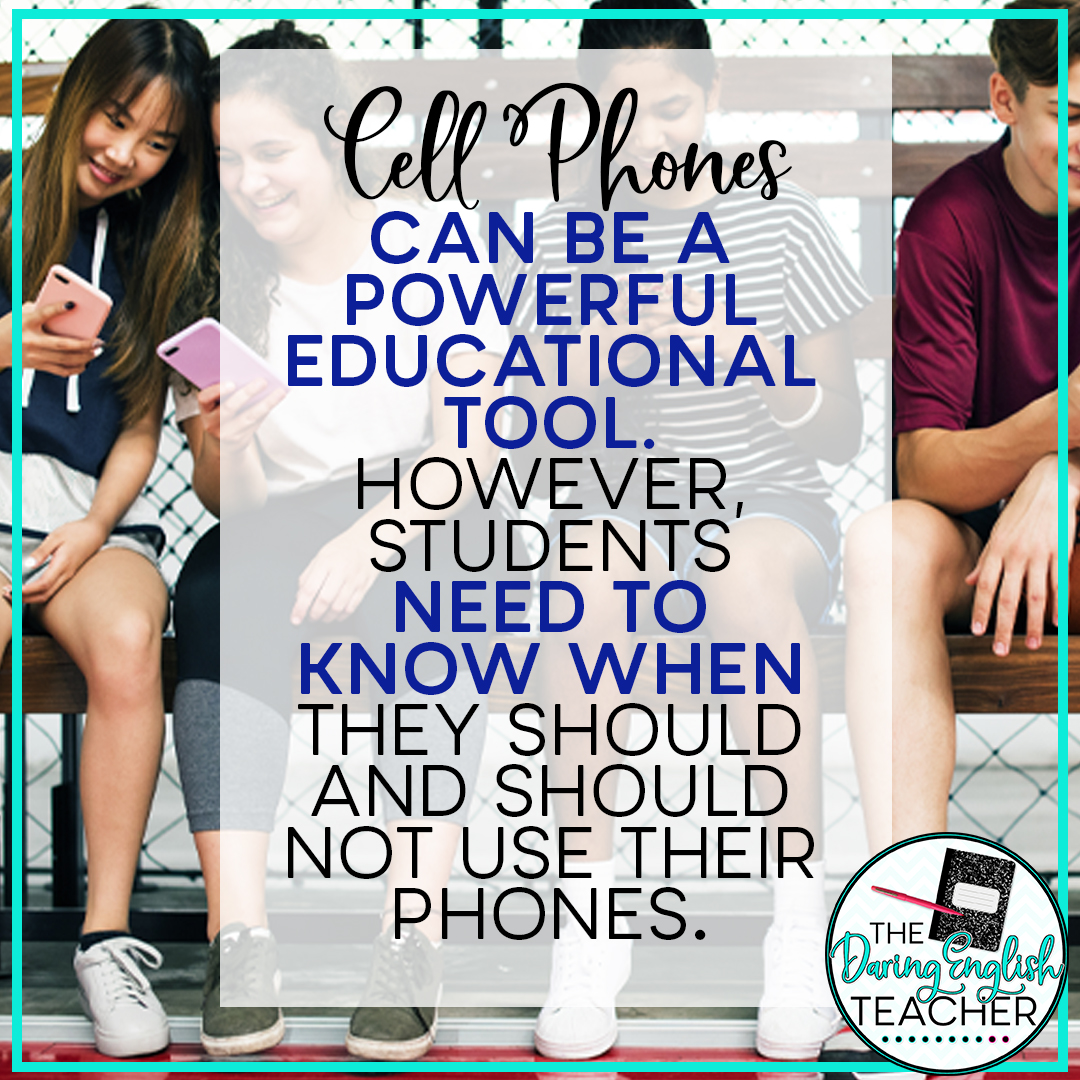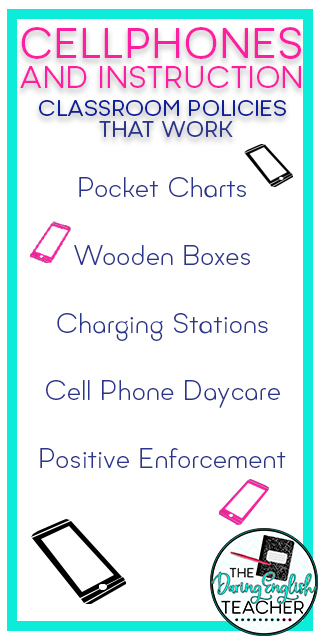There’s a lot to be said about technology, cell phones in particular, in the classroom. On the one hand, students can use them as a learning tool -especially in schools that are not 1:1. On the other hand, cell phones are highly distracting and can impede learning if student use is not strictly enforced.
I’ve taught at two different schools, and each had a different policy.
My first school had a site-wide cell phone policy. Students were not to use their phones in class. If they did, teachers could confiscate the phone and turn it into the office. Students or parents would then pick up the device after school. It worked, somewhat. You see, it wasn’t followed and enforced uniformly on campus. Some teachers allowed student cell phone use (not just for academic purposes), and other teachers did not. Since every single teacher wasn’t on board, the policy wasn’t effective.
Furthermore, students knew that if they put up enough of a fight, nothing would happen. For example, at my old school, I tried my best to follow the school policy consistently. One day, a student refused to hand over her phone. I explained that she was now acting defiantly as well. She still refused. I called security to have her escorted to the office. The student was escorted out of my classroom and taken to her counselor. (Yes, this is overkill, and this was in my earlier teaching days. I genuinely believe that such action is more disruptive to the classroom than a student being on their phone. This was one of those learning and reflective experiences for me). The student refused to give her phone to the counselor, to the assistant principal, and then she even refused to hand her phone over to the school resource officer -a Sheriff’s Deputy!
Now, this was right around the time when a video went viral showing a school resource officer using excessive force against a teenage girl in the classroom for the same thing. Since my student did not allow our school’s deputy to take the phone, she returned to class without any consequences whatsoever -with her phone in her hand.
School cell phone policies only work if they are uniformly enforced on campus. Teachers, administration, school support staff, and even parents have to be on board -and that is asking a lot.
My current school has a district-wide policy. According to the handbook, students are allowed to have phones on and in class, but they cannot use them for personal reasons (texting, social media, etc.). However, it is up to individual teachers to not only enforce that policy but also to police student cell phone use. Without consistent consequences across a school’s campus, it is a losing battle. And in a way, we as an educational society should be teaching proper tech use rather than monitoring and policing cell phones in the classroom.
As a teacher, I’ve seen the detrimental effect cell phones have on students. I started my teaching career at a time when only a couple of students had phones, but data was much too expensive for them to use them in class. Now, students are less engaged, more likely to listen to music during instructional time, and have shorter attention spans. A lesson on proper semicolon usage simply cannot compete with the temptation of cell phones, alerts, notifications, group chats, social media, and YouTube. Adding to the negativity, cell phone use amongst students has also drastically increased cheating and copying, it can hinder student sleep, and student cell phone use can contribute to feelings of depression and anxiety. However, we needn’t dwell on the negatives.
I’ve also seen the value that cell phones can bring to education. Students who might not have access to computers at home can type and submit essays on their phones. Students can quickly look up some information and verify its validity. Furthermore, students can also use their cell phones to collaborate with their peers.
Cell phones can be a powerful education tool. However, students need to know when they should and should not be allowed to use their phones. Furthermore, schools need to enforce policies on campus so that teachers are supported uniformly, learning can take place, and students have a sense of consistency.
Classroom Cell Phone Policies
A while back, I posted an Instagram story about student cell phone use, and I was overwhelmed by the responses I received. I shared my frustration with fellow educators. Some sympathized and related, and others offered great advice.
There are many ways to handle student cell phone use in the classroom. And while cell phones can be used for educational purposes, let’s be real. Many students also check social media, post content, text, watch videos, and participate in group chats during class. With that said, I’ve outlined several classroom cell phone policies and practices to try in your classroom. This post contains affiliate links. While they are of no extra cost to you, I may receive a small kickback for referring you to these items.
Pocket Charts
Out of all of the cell phone solutions I’ve seen, the pocket chart is by far one of my most common solutions. At the beginning of class, students come in and place their cell phones in their designated space in the pocket chart.
Teaching high school, I can have up to 36 students in my classroom. That’s why I love this pocket holder that is already numbered, and it has spaces for 36 phones!
Wooden Storage Box
Another option is storing cell phones in a wooden box. One advantage the wooden box has over the hanging pocket organizer is that, if placed in a secure location, the box will not fall. Some teachers have a concern that the hanging pocket charts might be too heavy with the weight of 36 phones and fall. These wooden boxes, while a bit more expensive, solve that solution.
This wooden box has a dedicated space for 24 phones.
This wooden box is ideal for the high school classroom because it has 36 dedicated spaces for phones.
And while we are on the subject of storing student phones, this cell phone storage cabinet is an absolute dream. It can be mounted on the wall, it has a transparent door so students can see their phones inside, and it comes with a key so that devices can be locked inside the cabinet for the entire class period. It truly is a dream. However, with its hefty price tag, this solution should be more of a district or a school purchase.
How to Implement the Pocket Chart or Cell Phone Box
With these solutions, the pocket charts or the wooden boxes, you can hold students accountable in a couple of different ways. One way would be to take attendance using the cell phone holder. Students who do not place their phones in the holders are marked either absent or tardy. For this option, you’ll want to check with admin because it could impede average daily attendance and funding if you teach at a public school.
If you can’t use attendance as an accountability tool, you could use participation points. You can make placing their phone in the boxes a classroom grade, or you can offer extra credit points as accountability. Whichever you choose, make sure you follow your school’s guidelines for grades.
Charging Stations
Another excellent option for storing student cell phones in the classroom is to provide students with a cell phone charging station. By providing students with a place to charge their cell phones, they are much more likely to put the devices away and out of sight for the class period.
There are quite a few different ways to create a cell phone charging station in your classroom. One of the easiest ways is to utilize a surge protector that has additional outlets and USB charging ports. This option is great because it provides a dedicated space for students to charge their phone.
Another option is to use a dedicated phone charging system. This cell phone charging station comes with the cords already, and it holds six and charges six phones at once.
However, you might need more space. After all, our class sizes can be pretty high. The most students I’ve ever had in a single class was 38. It was tough, and it was also my first year of teaching.
This charging station holds and charges ten phones at once.
Cell Phone Daycare/Cell Phone Jail
One management tool that works well in conjunction with the charging stations is a cell phone jail. If students opt not to charge their phones and use them in class instead, their phones get sent to jail -or daycare. Using the term daycare might be a little less harsh.
Positive Enforcement
Most of the solutions mentioned above rely on negative reinforcement. If that isn’t your classroom management style, there are a variety of positive reinforcement strategies to try in the classroom. I tried Pocket Points (not a paid endorsement or sponsorship) at the end of the last semester, and I had a pretty good experience with it.
For more book and teacher recommendations, be sure to check out my Amazon Storefront. It is filled with book recommendations and my favorite classroom supplies.
Allowing Cell Phone Use
Allowing cell phone use in the classroom can be beneficial if teachers can manage smart student cell phone use in the classroom. Smart cell phone use includes allowing students to check their phones during independent work. And likewise, students also know not to engage with their phones during instruction time and group work.
Another form of allowing students to use cell phones in the classroom is by incorporating designated cell phone breaks into the instruction time. Anecdotally, if students know they will be given a three-minute cell phone break in the middle of the class, they might be less likely to sneak cell phone use during class time.
Whichever cell phone policy you decide to adopt in your classroom, consistency is critical. You’ll want to stick with the policy and enforce it uniformly. However, and I’ve been there, sometimes classroom policies just don’t work. It is okay to abandon a classroom policy if it doesn’t work for you, your classroom, and your students.
I’ve found that the best time to change classroom policies is either at the semester or quarter breaks. If you do choose to switch policies in the middle of the year, you’ll want to communicate those changes with your stakeholders: students, parents, and maybe admin as well.





